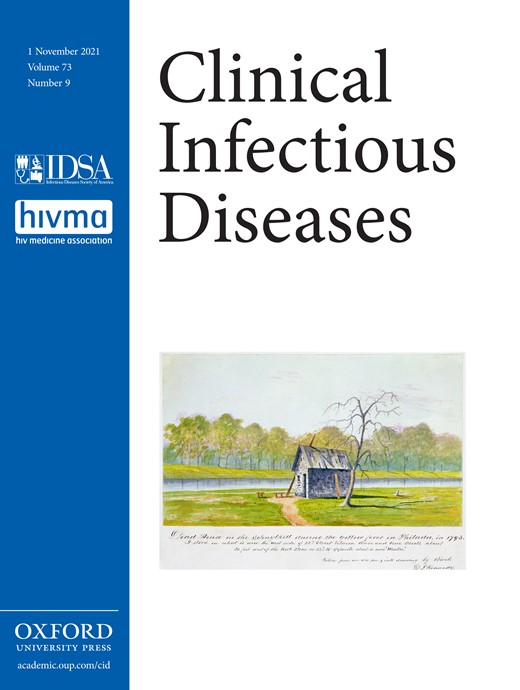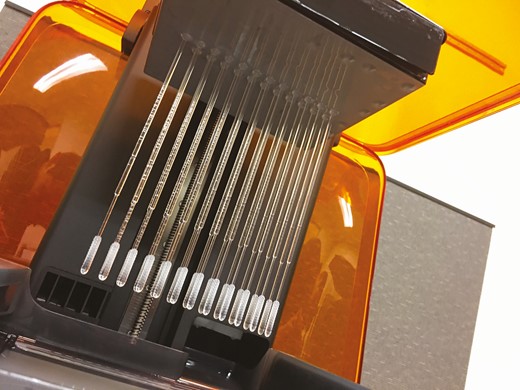-
PDF
- Split View
-
Views
-
Cite
Cite
Frank J Rybicki, 3D Printing in Medicine: Coronavirus Disease 2019 Testing With 3D Printed Nasopharyngeal Swabs, Clinical Infectious Diseases, Volume 73, Issue 9, 1 November 2021, Pages e3033–e3035, https://doi.org/10.1093/cid/ciaa1437
Close - Share Icon Share
(See the Major Article by Decker et al on pages e3027–32.)
3D printing a device to collect human severe acute respiratory syndrome coronavirus 2 (SARS-CoV-2) samples was an unlikely intersection point for 2 cultures to collide. These cultures shed perspective on the article by Decker et al in this issue of Clinical Infectious Diseases [1] and show how people with no prior information on infectious diseases impacted the pandemic response [2]—usually for better, but sometimes for worse.
The first culture is generally called the “maker culture” and includes 3D printing; it embraces and thrives on the open exchange of ideas, repurposing and making incremental improvements on designs via websites and publications among like-minded “makers.” Neither profitability nor global impact is ignored, but they typically fall in line with the “maker” culture of collaboration and advancement of science. The second culture is embedded within medical device companies and other 3D printing companies with verticals in the medical sector. That culture follows more traditional profitability and scalability inherent in marketing and selling products that are cleared for intended use, for example, by the US Food and Drug Administration (FDA) or Health Canada. Based on more than a decade of experience and practical circumstances, that culture includes unpublished quality control methods, trade secrets, and customer (eg, hospitals and individual physician) relationships.
In 2016, the Radiological Society of North America (RSNA) launched a Special Interest Group on 3D Printing [3]. One important, long-term goal was to gently and patiently fold together these 2 cultures [4]. This included creating a new membership category within a nearly century-old society where industry members could, for the first time, join the RSNA with equal voting privileges to physicians. A figurative creative kitchen developed, with the first recipes focused on clinically appropriate 3D printed representations of computed tomographic scans and surgical guides [5]. Coronavirus disease 2019 (COVID-19), a paucity of information about testing, and the resulting critical shortage of nasopharyngeal swabs has—at least in the short term—moved that work from a kitchen to a cyclotron laboratory. At light speed, the collision of cultures and participants produced many impressive results, and it also revealed shortcomings. The purpose of this editorial is to place the contribution of Decker et al [1] into context of the larger 3D manufacturing community.
MARKETING AND SELLING OF OPEN SOURCE DESIGNS, OR THOSE WITH SMALL MODIFICATIONS
Although University of South Florida (USF) Health holds provisional patents (first granted 20 March 2020) on the concept and design of the 3D printed swab, they immediately and freely provided it to hospitals and clinics to address supply chain shortages. The rationale was that swabs could be produced using desktop printers already present in hospital 3D printing labs, or “from [3D printing] bench to bedside.” Based on my own experience, the cost of all materials per swab using the methods described is roughly 25 cents (Figure 1).
The University of South Florida Health–designed nasopharyngeal swab 3D printed at the University of Cincinnati College of Engineering and Applied Science Digital Fabrication Laboratory on a Form 3 (Formlabs, Cambridge, Massachusetts) using International Organization for Standardization (ISO) 10993-1:2018 biocompatible Surgical Guide Resin, produced using virgin build and postprocessing equipment for clinical use. Image oriented looking upward at the swabs hanging from the build plate and shows 23 swabs after a test build prior to a production job that would produce approximately 200 swabs in 24 hours. Image courtesy of Sam Antoline.
Also, in the spirit of collaboration, the authors opened their clinical trial nationally, moving the local human research committee ethics approval to a national platform (Western Institutional Review Board, Inc) so that any investigator could collaborate. Furthermore, while the dire need for swabs remained, USF placed a 1-year embargo on any revenues from the swab itself, further enabling the design to be utilized by as many hospitals as possible and slow the spread of the virus.
This goodwill was not always used constructively, and in some instances the ensuing behavior was deplorable. Some companies and individuals with the specific 3D printing platform used cultural goodwill and openness for profit. There were 3D printed swabs sold—even to state governments, with fees dramatically beyond costs. This avarice was compounded by the fact that hospitals and large agencies needed to conserve healthcare dollars more than ever. Others made small modifications to get around the patented design, with an additional negative consequence of inconsistency among the swabs. We now know that many related designs are safe and suitable for clinical use, but that uncertainty cost precious time and trust among infectious disease specialists, hospital administrators, and frontline workers who were used to the consistency seen in the packaging and feel of commercial products.
THE USE AND POTENTIAL MISUSE OF THE 3D PRINTED NASOPHARYNGEAL SWAB DESIGN AND MATERIALS
Infectious disease experts, pathologists, nurses, and leaders from the medical 3D printing community voiced concerns about how a printed swab could be as safe or gentle to the nasopharyngeal tract when compared to the flocked swab. Volunteer testing (including those from USF Health and Northwell Health) showed that there were no differences in discomfort or issues with breakages [6]. Anecdotal reports suggested that some patients tested with both swabs preferred the 3D printed one, and training with a focus on the test tube breakpoint provides reassurance. Additional data [7, 8] should be interpreted with the current demonstration that the 3D printed swab is equivalent to commercial flocked swabs [1].
Chemical compounds are essential to 3D printing, particularly in medical applications when there is contact between the 3D printed part and the patient. In part because of the 2 different cultures, many medical experts are not familiar with how deeply 3D printing has permeated medicine and dentistry. Subsequently, there was and still is a misconception regarding the ability of an in-hospital 3D printing laboratory to generate a part that is equivalent to a commercial product for an intended use. The swabs are created from a surgical-grade material cleared to come in contact with internal human tissues. The 3D printed swabs are rinsed in isopropyl alcohol [9] and cured following guidelines to ensure that they are not cytotoxic. 3D printing quality assurance includes an individual human review of each swab to ensure that it appears straight, is free from defects, and has no residual resin—all before an infectious disease team reexamines each swab, autoclaves them, and then bundles them with the rest of the test kit materials.
REGULATORY CONSIDERATIONS
From the FDA’s perspective, the key difference between the nasopharyngeal swab and other 3D printed parts [10] during the COVID-19 pandemic is the fact that swabs must be used sterile. Specifically, the risk of the swab contaminating the test result has elevated the overall efforts into a more controlled class I exempt status for medical devices [11]. The FDA reviews and lists class I medical devices, although they are not considered “cleared” as is commonly referred to for class II medical devices. Nonetheless, cultural disconnect, regulatory illiteracy, and some skepticism prompted hospital administrators to repeatedly ask that 3D printed swabs “be cleared by the FDA.” The demand for clarity and discussion stirred up enough controversy that the FDA convened a special midpandemic virtual town hall on 15 May 2020; unofficial attendance count may have been 1000 attendees [12]. Over the past decade, and particularly during the past 5 years, I have developed enormous respect for the role and responsibilities of the FDA to keep Americans safe, including admiration for the individuals who maintain this role for 3D printing and inherently are charged to help manage and integrate the different cultures.
LIMITATIONS
Longer-term data are lacking, and only a small number of sites are enrolled in any one study. USF Health provided coaching outside their institution during bench lab testing without requiring trial enrollment. Other hospitals had limited swabs, resorted to a “conservation” mode, and were unwilling to use precious commercial swabs for any experimentation. Finally, the pediatric population is not represented by this study.
CONCLUSIONS
3D printing has an expanding role in hospitals, enabling a novel pathway for medical engineers and scientists to work with physicians to positively impact patient care. COVID-19 supply shortages extended this role to infection disease specialists. While a 3D printing laboratory has the potential to generate a part that is equivalent to a commercial product cleared by the FDA for an intended use, cultural differences exist and impact the rate at which 3D printed parts will be made and used in hospitals. Among all parts 3D printed during COVID-19, nasopharyngeal swabs have received the most attention, with participants ranging from humanitarians to charlatans. The authors should be congratulated for staying on the right side of the curve and for their perseverance, leadership, scientific rigor, and goodwill.
Note
Potential conflicts of interest.The author: No reported conflicts of interest. The author has submitted the ICMJE Form for Disclosure of Potential Conflicts of Interest.






Comments